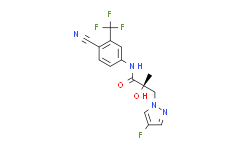| Cas No.: | 2168525-92-4 |
| Chemical Name: | (2S)-N-[4-Cyano-3-(trifluoromethyl)phenyl]-3-(4-fluoropyrazol-1-yl)-2-hydroxy-2-methylpropanamide |
| Synonyms: | s8885;(2S)-N-[4-Cyano-3-(trifluoromethyl)phenyl]-3-(4-fluoropyrazol-1-yl)-2-hydroxy-2-methylpropanamide |
| SMILES: | FC1C([H])=NN(C=1[H])C([H])([H])[C@](C(N([H])C1C([H])=C([H])C(C#N)=C(C(F)(F)F)C=1[H])=O)(C([H])([H])[H])O[H] |
| Formula: | C15H12F4N4O2 |
| M.Wt: | 356.2750 |
| Purity: | >98% |
| Sotrage: | 2 years -20°C Powder, 2 weeks 4°C in DMSO, 6 months -80°C in DMSO |
| Description: | UT-34 is a potent, selective and orally active second-generation pan-androgen receptor (AR) antagonist and degrader with IC50s of 211.7 nM, 262.4 nM and 215.7 nM for wild-type, F876L and W741L AR, respectively. UT-34 binds to ligand-binding domain (LBD) and function-1 (AF-1) domains and requires ubiquitin proteasome pathway to degrade the AR. UT-34 has anti-prostate cancer efficacy[1][2]. |
| Target: | IC50: 211.7 nM (Wild-type AR), 262.4 nM (F876L AR) and 215.7 nM (W741L AR)[1] |
| In Vivo: | UT-34 (20-40 mg/kg; oral administration; daily; for 14 days; NSG mice) at 20 and 40 mg/kg reduces the seminal vesicle weight by 10%-20% and 50%-60 %, respectively[1]. UT-34 inhibits androgen-dependent tissues such as prostate and seminal vesicles in rats, and the growth of Enzalutamide-resistant castration-resistant prostate cancer (CRPC) xenografts. UT-34 also induces tumor regression in intact immunocompromised rats[1]. Animal Model: Non obese diabetic/severe combined immunodeficiency Gamma (NSG) mice injected with MR49F cells[1] Dosage: 20 mg/kg or 40 mg/kg Administration: Oral administration; daily; for 14 days Result: Reduced the seminal vesicle weight. |
| In Vitro: | UT-34 (3-10 µM; 24 hours; LNCaP cells) treatment inhibits the expression of PSA and FKBP5 and growth of LNCaP cells starting from 100 nM with maximum effect observed at 10 μM[1]. UT-34 (0.1-10 µM; 24 hours; LNCaP cells) treatment results in a reduction of AR levels at 1000 nM in LNCaP cells[1]. Treatment of ZR-75-1 cells maintained in serum-containing growth medium with UT-34 results in downregulation of AR protein levels, but not estrogen receptor (ER) or progesterone receptor (PR) levels. Furthermore, in MDA-MB-453 breast cancer cells that express AR and glucocorticoid receptor (GR), UT-34 induces the downregulation of AR, but not GR[1]. UT-34 is an effective degrader of both AR and AR-V7. LNCaP-ARV7 cells are treated for 24 hours in the presence of 0.1 nM R1881 or 10 ng/mL Doxycycline. Doxycycline induces the expression of EDN2, which is inhibited by UT-34, while UT-34 inhibits the expression of R1881-induced FKBP5 gene expression[1]. Cell Viability Assay[1] Cell Line: LNCaP cells Concentration: 3 µM, 10 µM Incubation Time: 24 hours Result: Inhibited the expression of PSA and FKBP5 and growth of LNCaP cells starting from 100 nM with maximum effect observed at 10 μM. Western Blot Analysis[1] Cell Line: LNCaP cells Concentration: 0.1 µM, 1 µM, 10 µM Incubation Time: 24 hours Result: Resulted in a reduction of AR levels at 1000 nM. |
| References: | [1]. Ponnusamy S, et al. Orally Bioavailable Androgen Receptor Degrader, Potential Next-Generation Therapeutic for Enzalutamide-Resistant Prostate Cancer. Clin Cancer Res. 2019 Nov 15;25(22):6764-6780. [2]. Stone L. UT-34: a promising new AR degrader. Nat Rev Urol. 2019 Nov;16(11):640. |

 To enhance service speed and avoid tariff delays, we've opened a US warehouse. All US orders ship directly from our US facility.
To enhance service speed and avoid tariff delays, we've opened a US warehouse. All US orders ship directly from our US facility.




















